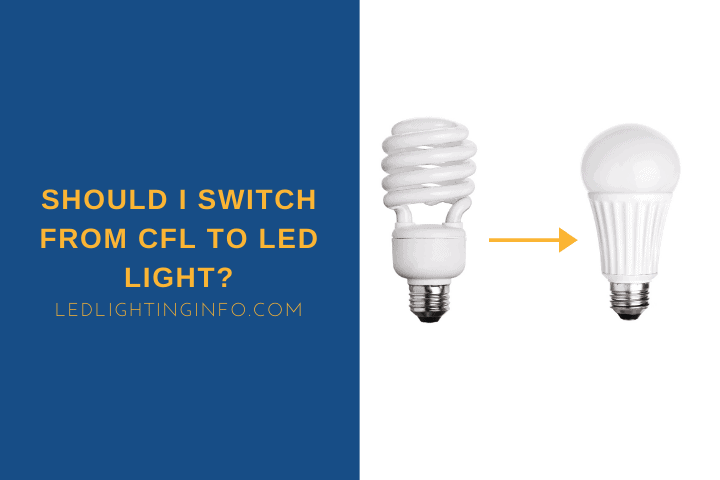LED bulbs are, generally speaking, the most energy-efficient light bulbs you can buy for your home, and I never hesitate to recommend replacing older incandescent bulbs with LEDs as soon as you get the chance.
But what about CFLs?
CFLs are also more efficient than incandescent lights. You might have already started making the change to CFL when you realized that LEDs perform better. So, is it worth switching from CFL to LED?
If your CFL bulbs are working, it’s usually not worth replacing them with LEDs immediately – LEDs are more efficient, but the savings aren’t huge. Only replace them now if your CFLs aren’t suited to the fitting or are damaging fabrics. Otherwise, wait until they’re burned out.
In this article I’ll explain:
- Why it’s probably not worth it to replace CFLs with LEDs immediately
- The actual differences between like-for-like CFL and LED bulbs
- What to be careful of when replacing CFL bulbs with LEDs
Is It Worth Replacing CFLs With LEDs?

Firstly, it’s worth a quick reminder of the differences between CFLs and LEDs (and how they compare to incandescent bulbs).
CFLs were the original next-big-thing in light bulb tech when they were introduced in the mid-1980s. They use a phosphorus coating and mercury vapor, which is electrically charged to create fluorescent light.
Compared to the filament-heating incandescent bulbs, they were much more energy-efficient. They lasted a lot longer, too – on average, around 10,000 hours compared to just 1,000 hours for incandescent.
However, that’s before LED bulbs were manufactured more widely. LEDs use semi-conducting light-emitting diodes that generate light when electricity is passed through them.
There are no harmful gasses, very little heat, and a much better lifespan – now up to 50,000 hours.
LEDs have other benefits over CFLs too. They generally run at a lower wattage for the same light output (which I cover in more detail below), CFLs can emit a lot of ultraviolet and infrared light, which can damage fabrics, something LEDs don’t do, and LEDs perform much better when directed by a fixture.
Also, CFL bulbs are known to have lower color rendering index (CRI) compared to LED and incandescent bulbs, which can make your home look dull.
So with all those benefits, it’s worth replacing them at the first opportunity, right? Well it depends – as I’ll explain now.
How Big Is The Difference In Energy Consumption?

If LED lights are much more energy-efficient than CFLs, then it would make sense to save money and replace all of your bulbs.
There are no other negatives to LEDs when compared to CFLs, so the only reason you might delay is a financial one.
So, let’s compare a CFL and an LED bulb that is essentially like-for-like.
For an ‘average’ 800 lumen output, you’ll need an incandescent bulb of 60 Watts. CFL bulb of 13 Watts and an LED bulb between 7 and 10 Watts vary slightly, so check the bulb before buying.
Also read: What Is The LED Watts Equivalent?
For a brighter light of around 1100 lumens, the incandescent bulb would be 75 Watts, the CFL 18 Watts, and the LED between 10 and 15 Watts.
If you turn that into an average Watts per lumen (W/lumen) rate you get:
- Incandescent – approx. 0.072 W/lumen
- CFL – approx. 0.016 W/lumen
- LED – approx. 0.01 W/lumen
The LED bulb clearly gives you more light per Watt – but how does that compare when it comes to actual energy costs?
Using the current average electricity rate of 13 cents per kilowatt hour, calculated against a 5-hour per day use, we can use this energy use calculator to work out:
- A 60W incandescent bulb would cost $14.24 per year
- A 13W CFL bulb would cost $3.08 per year
- A 9W LED bulb would cost $2.14 per year
It’s not just a per-year cost, though, as there’s also the bulb’s lifespan and cost to consider. And while an LED bulb might cost a few dollars more than a CFL, it could last for up to five times as long.
Over the number of bulbs you need for your home and how often you need to replace them, switching to LED will save you money.
Also, take into account that this straight-forward comparison doesn’t always work. That’s because an LED bulb will work much more efficiently in a directed fitting, while a CFL suffers from light leakage more.
You might not need as many lumens from your LED bulb to get the equivalent lux effect of a CFL since it’ll do a better job at directing the light.
The savings may not be huge, but you might be able to get a lower-equivalent LED bulb with the same results and save more.
Definitively, LEDs are better, and It’s definitely worth making the change to LEDs when your CFLs burn out, and possibly sooner – but you won’t save hundreds of dollars if you swap out working CFLs, so consider being patient.
Related content: What Is The Difference Between Lumen And Lux?
Main Watchouts When Transitioning To LEDs

If you do decide to make the switch from CFL to LED, there are a few things to watch out for.
Firstly, you need to make sure that the base and bulb size match to fit the new LED bulb.
If you have a ‘standard’ light fitting, then it’s likely you just need to match up the pin connection, but it’s best to check bulb size too. LEDs aren’t usually larger than CFLs, yet you shouldn’t assume.
CFLs commonly have 2- or 4-pin bases instead of the more typical screw-in base for LEDs, but you can either replace the fitting or find a matching LED.
Also, consider the voltage. Suppose you’re buying a generic LED bulb. In that case, it’ll likely have a universal voltage, so it should work fine, but if you’re buying a specialist bulb or the fitting is a specific CFL fitting. You may need to find something more specific.
And finally, a more generic point, but always be careful when disposing of CFL bulbs. They contain mercury vapor and, if broken, could be dangerous. You’d likely need to break many bulbs to have a significant problem, but better to be safe. CFL bulbs should be recycled at your local center.
Final Words
LEDs have many benefits over CFL bulbs, but do you need to immediately replace your working CFL bulbs?
Probably not, unless your CFL bulbs aren’t directing light effectively in the fitting, or they’re potentially damaging sensitive fabrics in your home.
Long-term, LEDs are the future, and I’d suggest replacing a CFL with an LED as soon as it turns out – just make sure you find one that will work in the fitting.
Eventually, you’ll save money and have to replace your bulbs less frequently too.
Is your home full of CFLs, or have you already transitioned to LEDs? Let me know in the comments, along with any questions you might have.
Looking for an LED bulb but not sure what type you need?
Check out my free bulb picker and select the right bulb within few clicks.

